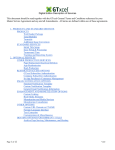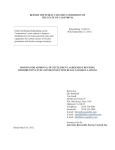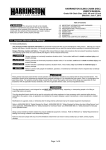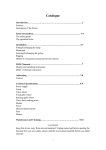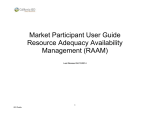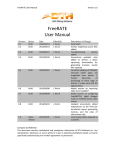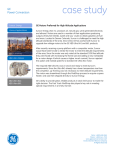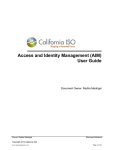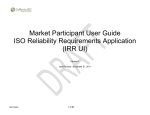Download CAISO BSAP User Guide
Transcript
California ISO BSAP Users Guide June 8, 2015 Revision History Version: Release Date: 1.1 6/8/2015 California ISO BSAP Users Guide Date 6/8/2015 Version 1.1 By WT 11/4/14 1.0 WT Description Created BSAP User Guide from the version 5.0 SIBR BSAP User Guide. Fall 2014 Release Functionality added. (Wheeling, Transaction base schedules) EIM Base Schedule. To the BSAP Scheduling Coordinator User Guide Version 5.0. Page 2 California ISO BSAP User Guide Contents 1 Introduction .......................................................................................................4 1.1 Overview ................................................................................................................................ 5 1.1.1 Theory 5 1.1.2 Practice 7 2 Common UI Features & Navigation .................................................................8 2.1 Application – Specific Menu ................................................................................................... 8 2.2 Application Content Area ....................................................................................................... 9 2.3 BSAP Screens......................................................................................................................14 2.3.1 BSAP Base Schedule sub tab 14 2.3.2 BSAP Base Balance Viewer 19 2.3.3 BSAP Resource Bal Viewer 20 3 FAQ ...................................................................................................................24 3.1.1 3.1.2 3.1.3 General Questions Questions About Base schedules Questions About Users and Permissions 24 26 27 4 Appendix A ......................................................................................................28 Page 3 1 California ISO SIBR - System Coordinator User Guide Introduction Purpose The introduction of the Energy Imbalance Market (EIM) will allow balancing authorities (BA) throughout the West to participate in a real-time imbalance energy market operated by the ISO. The EIM will dispatch economic base schedules to efficiently balance supply and load within its footprint, providing substantial benefits. Broad participation in an imbalance market will bring important efficiency, reliability benefits and provide a valuable and important role in renewable integration, helping to balance variable resources. One part of the CAISO system is the Base Schedule Aggregation Portal (BSAP) component. From the viewpoint of an EIM participant either as the Base Schedule Coordinator (BSC) or the EIM Entity BSC who interacts with the system, this component: Accepts base schedules for energy and energy-related commodities (future functionality) from the BSC or Entity BSC that are certified to interact with CAISO, Ensures that those base schedules are valid and that the Balancing Area Authority (BAA) is reporting the balance aggregated base schedules within the BAA for the demand forecast related to the BAA zone for a given time period. BSC or Entity BSC enters base schedules into BSAP for processing by other components of CAISO’s management systems, using the data from the database and Provides required feedback to BSCs concerning base schedules that have been submitted. This manual will instruct a Base Schedule Coordinator (BSC) in the usage of the California ISO Base Schedule Aggregation Portal (BSAP) web user interface for entering and submitting base schedule data. Audience & Prerequisites This manual is intended to be used by persons who wish to use the web-based user interface supplied by the CAISO system to submit base schedules for energy and energy-related commodities and services How to Use This Manual The organization of this manual is as follows: Chapter 1 is introductory material. Notably, it contains an overview of the process that the California ISO (and the software system that has been put into place by CAISO) follows in accepting and evaluating base schedules. This material is useful in understanding how base schedules are processed including base schedule statuses, the order in which processing steps occur, etc. The chapter also explains how to access the system. All users of the system should read this chapter. Chapter 2 describes basics of the user interface used to enter base schedules. All user interface screens are constructed of certain basic elements; they are described here. All users who will interact with the BSAP User Interface should read this chapter. Page 4 California ISO BSAP Users Guide Chapter 3 discusses the components of base schedules and how to enter them. It also describes how to submit base schedules, how to view base schedule status as a base schedule progresses through the system, how to cancel a base schedule, how to create a new base schedule to replace one that is already in the system, etc. Personnel, who enter, submit, or need to view the status of base schedules should read this chapter. Appendix A is a link to the SIBR Rules which has a tab for Terms, these terms are used within the rules engine when checking the content and validation of Base Schedules and bids. 1.1 Overview The following chapter will discuss how the base scheduling process works at the California ISO, using the software system that has been jointly designed by CAISO and Siemens and built by Siemens. Not only will we discuss how the process works, but we will also establish a common vocabulary for that discussion. Note that the overview in this chapter is not intended to explain every detail of the process. It will, however describe the major steps in base schedule processing. The overview is in three sections: Theory: where we explain how the main flows in the process work. Practice: where we discuss in general terms how a BSC interacts with the system via the user interface. FAQ: where we answer questions – some which have come from customers and some that we’ve made up ourselves on behalf of customers. 1.1.1 Theory 1.1.1.1 Base Schedule What is a “Base Schedule”? A Base Schedule is a forward energy schedule, with hourly granularity, that is the baseline to measure deviations for settlement through the EIM. Base schedules include the hourly forecasts of load, hourly generation schedules and hourly interchange schedules. How is a Base Schedule Created & Submitted? Although this process seems simple, there are important subtleties. Specifically, there is an important difference between “created base schedule” and “submitted base schedule”. A BSC uses the GUI to create a base schedule by entering values for all the base schedule components. During this process, beyond some very simple validation (e.g., no alpha characters in numeric fields) and saving the base schedule in the database, the system takes little interest in the actual contents of the base schedule. After the BSC has created the base schedule, it is submitted by clicking a button on the base schedule creation page. At this point, the system queues the base schedule for validation by the “rules engine” and informs the SC that the base schedule has been submitted. Page 5 California ISO BSAP Users Guide After a base schedule is submitted, the system maintains a complete history of the base schedule and actions performed. The BSC can view the base schedules; it may also be used as the basis for creating another base schedule. How is a Real-Time Base Schedule Validated? Once an SC submits a base schedule, it is available for the system to validate. The BSAP Rules Engine performs validation. The BSAP Rules Engine is programmed with several rules that are used to validate the base schedule. The process of validating a base schedule actually takes place in multiple steps; however, these multiple steps are automatic and are seamless to the user. Content Validation determines that the base schedule adheres to the structural rules required of all base schedules. This includes such things as validating that all required components are present, the units or services contained in the base schedule actually exist, etc. If the Content check fails, the base schedule becomes a “Rejected Base schedule”. After Content succeeds, Base schedule Validation verifies that the various components of the base schedule adhere to the applicable market rules. If this validation passes, the base schedule becomes eligible to be used in a market. At this point, the BSC has the option to view the base schedule and edit or cancel if needed: Cancel the base schedule, in which case the base schedule is retained in the system database as a Cancelled Base schedule. Cancelled base schedules will not be further processed. o Note: Cancel is used for Market Accepted base schedules; those are base schedules that are in a valid status. Do not use ‘Delete’ for Market Accepted base schedules, Delete is for base schedules that are in a ‘Create’, ‘Invalid’ or ‘Rejected’ status. Modify and re-submit the base schedule, in which case the original base schedule is retained in the system database as an Obsolete Base schedule. Obsolete base schedules will not be further processed. If the base schedule is re-submitted, processing begins again. Master File changes are introduced into the system once per day. Since Master File changes may affect base schedule acceptance for new or changing resources close attention is needed when submitting for future dates. Base schedules for the Day-Ahead market may be submitted up to 7 days in advance. Therefore, a base schedule that is submitted on Monday afternoon for Thursday’s Day Ahead Market that has a status of Valid may not be processed after the close of the Thursday market to take into account any Master File changes that may have occurred. Base schedules currently do not go through a re-validation process after Master File changes are applied. Page 6 California ISO BSAP Users Guide 1.1.2 Practice 1.1.2.1 In the last several pages, we have discussed how base schedules are validated by BSAP. In the following chapter, we’ll cover in general terms, the practical aspects of accessing the system, entering, submitting, and managing base schedules. The goal here is to understand the basic principles and processes – later chapters will address particulars such as which buttons to push and when. Basic Display Layout Application-Specific Menu As stated previously, this document is concerned with entry, submission, and management of base schedules. In this case, the Application-Specific menu will contain the following items: Base Schedule: Screen accessible through this menu item is used to create, submit, and manage base schedules for a day-ahead and real-time market. BAA Balance Viewer – Screen is a view of the aggregated base schedules for the BAA compared to the Demand Forecast for that BAA to show the delta MW between the two and the percentage, this is used to manage the balancing. (Note – other data on this view will show aggregated outage information for the BAA and if there is any base schedule deviation to account for when balancing). Resource BAL Viewer – shows the resource specific data with respect to the base schedule, operating limits, bid limits, outage related information and impact to base schedule deviation. Page 7 2 California ISO BSAP Users Guide Common UI Features & Navigation There are a number of elements that appear on all (or many) GUI pages. We’ve already talked about some of them: Portal Menu Application Menu Logout and Help links. Application Content Area. In this chapter, we’ll talk about other common display elements and concepts. A Couple of Important Definitions… Base schedules are submitted for a market. There are two market types: 1 A Day-Ahead Market is basically one 24-hour period. Base schedules for a Day-Ahead market may be submitted up to 7 days in advance of the target market date. Base schedules may be submitted until the “market close” event for the target market date (currently 10:00 A.M.) on the previous day. A Real-Time Market consists of one hour. Real-Time Market base schedules (for a particular trade day) are accepted up to 7 days in advance of the target market date until the real-time market for the designate hour closes. (T-75 xx:45, T-55 xx:05, T-40 xx:20) 2.1 Application – Specific Menu The BSAP application menu shown in contains the following items: (Figures 1 and 2 show these items) Navigation Tool Bar Base Schedule BAA Balance Viewer Resource Bal Viewer 1 There is one 23-hour (no HE3) and one 25-hour (has HE2* for second HE2) Day Ahead Market per year due to daylight savings time. Page 8 California ISO BSAP Users Guide Figure 1: BSAP Application Menu Selection Tab Menu Navigation Previous Page Figure 2: Navigation Toolbar Next Page Stop Page Loading Refresh Page Print Page 2.2 Application Content Area For most Base schedule Management displays, there are three basic components in the Application Content Area, as illustrated in 3. These are: Filter Pane: The filter pane is present on most BSAP displays. It contains filters that allow the user to control the information displayed on the data grid portion of the display. The filter pane is always at the upper edge of the Application Content Area. Data Grid(s): Below the filter pane is at least one data grid. Base schedule data are entered, edited, and viewed in the data grid. Some displays may have additional data grids. Message Bar: This is at the very bottom of the Application Content Area. It is used to advise the user of various events, errors, etc. This area grows and shrinks vertically to accommodate the message(s) that need to be shown. Page 9 California ISO BSAP Users Guide Controls on the Grid A number of icons may be included at the upper left corner of the data grid. Table 1 describes the buttons that are available on tabular grids. Table 1: Buttons on Tabular Grids Collapse / Restore grid. This button collapses (restores) a tabular grid. When a grid is collapsed, the title of the grid remains visible. Restore Default Sort. It is possible to change the sort order of the contents of a tabular display by clicking on the title row. Clicking on the Restore Default Sort button restores the sort order to the default, that is, it removes any sorting that has been established by clicking on title rows. Export. By clicking on this button, the user may export grid contents (either displayed contents or the entire contents of the database table(s) used to populate the grid) to Microsoft Excel, Microsoft Word, or an XML file. Note that a configuration parameter controls the maximum number of rows that may be exported. This number is quite large; it is rare that tables exceed this size. Print. This button prints the contents of the grid. Note that there is another print button in the “common functions” area of the display. That button prints the contents of the entire display. Figure 3: Content Area Page 10 California ISO BSAP Users Guide Filter Pane Message Bar Data Grid Page 11 California ISO BSAP Users Guide Sorting the Grid The sort order of a tabular grid is established in the configuration file for that grid. The User may change the sort order by clicking on the title row for a column. For example, in the grid illustrated in Figure 5, the user has clicked once on EN header and twice on the Resource header (resources are masked). This changes the sort order of the grid by making the EN column the primary sort key and Resource the secondary sort key. A small triangle appears in the header row to indicate: Sort order. The orientation of the triangle (pointing up means ascending, pointing down means descending). Key: The small number in the triangle indicates which column is the first, second, etc. sort key. Up to 9 sort keys may be established in this way. As implied above, sorting may be ascending, descending, or none: Clicking once sorts in ascending order. Clicking a second time on the same column changes the order to descending. Clicking on the same column for a third time removes sorting. By clicking on the grid’s Restore Default Sort button, all sort keys can be removed and the sort order returned to default. Figure 5: Basic Display Components Page 12 California ISO BSAP Users Guide Scrolling the Grid Often the data grid of a tabular display is not large enough to display all the data in the corresponding columns of the database. In such a case, the grid may be configured to be “scrolled”. Scrolled Grid Some tabular grids may be configured for scrolling. In such a case, a scroll bar will be present on the right edge of the grid. This scroll bar is used to move forward and back in the data. Note that column headers and totals (if present) remain stationary as data are scrolled. Message Area The area immediately below the grid is used for messages. This area expands and shrinks as necessary to accommodate any messages that the application believes are of interest to the user. A separate display is provided to view messages that have occurred over a longer term, such as messages issued by the Rules Engine during base schedule processing. Input Accelerators There are two distinct methods of input acceleration on data tables. Both methods allow you to quickly and easily replicate duplicate data on a table. This is accomplished either by using pre-defined hotkey commands or by using the right-click menu. Hot Keys: When you want to copy the data from the current cell into all of the cells above or below, using the Alt + Up or Alt + Down commands is a fast way to do just that. Alt + Up/Down Commands Right-Click Menu: This menu gives you a list of commands associated with actions to perform on the entered data. Each of the functions is described in detail below. Copy/Mark: Copies or marks the contents of the selected cell or row Paste Row: Pastes the copied row into the currently selected row Paste Row Through: Pastes the copied row into all the rows up or down through the selected row Paste Cell: Pastes the copied cell into the currently selected cell Paste Cell Through: Pastes the copied cell into all the cells up or down through the selected cell Sum from Marked Cell: Sums up the values from the marked cell through the selected cell and displays the results as a message in the message area Right-Click Menu Page 13 California ISO BSAP Users Guide 2.3 BSAP Screens Must be logged in to the BSAP system and a resource must be eligible from Master File to be allowed to submit Base Schedules. There are three screens currently (Base Schedule, Base Balance Viewer and Resource Bal Viewer) Please see the Application Access page posted on CAISO web site for proper URL depending on which environment is used. This is updated when information changes periodically. http://www.caiso.com/participate/Pages/ApplicationAccess/Default.aspx Select the ‘System Access Information for Market Participants. 2.3.1 BSAP Base Schedule sub tab 1. Logging in to the BSAP system requires a valid certificate with the appropriate role in order to access the system. 2. The Base Schedule Screen page is the default page that is loaded. To view the header pane, double click the top Bar or select another sub tab and then back to the Base Schedule sub tab. Page 14 2.3.1.1 California ISO BSAP Users Guide 3. Select Criteria from the drop down boxes which includes: Scheduling Coordinator (SC of Participatin or Non-Participating resource) Resource Type Resource Scheduling Point Hour Primary Tie Direction Alternate Tie Energy Type PSE Identifier (Figure 6 Base Schedule select criteria) Figure 6 Base Schedule select criteria Submitting Base schedules The base schedule submission process is largely identical for both Day-Ahead and Real-Time base schedules. As we have discussed before, the only major difference is that Day-Ahead base schedules are for a full day and Real-Time base schedules are for a one-hour period. For both Day-Ahead and Real-Time base schedules, a Base schedule Summary menu item is provided; this display is used to review, submit, or cancel base schedules. Note: Cancel Base schedules are for Market Accepted base schedules, (Valid). To remove created base schedules or Invalid/Rejected base schedules, select base schedule, then delete. 1. The BSC / Entity BSC drop down is populated the associated role on the issued certificate to access BSAP. Page 15 California ISO BSAP Users Guide 2. 3. 4. 5. 6. If the role is associated with the Entity BSC, then the drop down will allow both the Entity BSC and all BSC that belong to the BAA under that Entity to be selected. Base Schedules require that the Scheduling Coordinator (this is the Financially Responsible SC) be entered in order to create a Base Schedule. This is a free form field to be typed. Once the resource is selected click on ‘Create’ button. Enter a MW value for the Base Schedule to be used. Then select Update Select check box for intervals and then Submit BS. This will submit the Base Schedules Figure 7 Base Schedule MW and update submit 3. Select Submit 2. Select Update 1.Enter EN MW Editing of base schedule information is performed by re-creating the base Schedule described in the submission. Page 16 2.3.1.2 2.3.1.3 California ISO BSAP Users Guide Figure 8 – Example Base MW and Status information displayed (resources masked) Canceling Base schedules To cancel a base schedule click the checkbox for each base schedule to be canceled. Then click the “Cancel Base schedules” button. This will remove the base schedule(s) from consideration by the system Note: Cancel Base schedules are for Market Accepted base schedules, (Valid). To remove created base schedules or Invalid/Rejected base schedules, select base schedule, then delete. Note: A base schedule may not be cancelled for a market that has closed. Base schedules may only be canceled for markets that are still open and for base schedules that are not invalid, rejected or in submit status. To delete a base schedule click the checkbox for each base schedule to be deleted. Then click the “delete” button. This will remove the base schedule(s) from the system. . Base Schedule Messages from Rules If a base schedule is submitted and found to have errors, it will come back with an error indicator. When base schedules are found to have errors they will come back either in an invalid or rejected state or a modified or MF Inserted state. The segment of the base schedule with errors will be highlighted in yellow. Clicking the error indicator will bring up a window listing the errors (rules) and any processing of the base schedule to correct them. Refer to Figure 9 for an example of a base schedule containing errors. Page 17 California ISO BSAP Users Guide Figure 9 Error Message display. Page 18 California ISO BSAP Users Guide 2.3.2 BSAP Base Balance Viewer To view the BAA Balance Viewer, navigate to the Base Schedule Screen page and select the Base Balancer Viewer Sub-Menu (Figure 10) This view identifies the EIM Aggregate compared to the Demand Forecast to identify the delta between the aggregated valid submitted Base Schedules and the Demand Forecast for that hour. The Demand Forecast is updated in the view 3 times per hour. Figure 10 – Example Balance displayed (sample only) The BAA Balance Viewer, display has many columns to provide information to the EIM Entity to assist in balancing activities for the BAA. The primary columns are the Aggregate BS, Demand Forecast (DF) and the Base-DF % which are highlighted above in Figure 10. The goal is to be balanced for a given hour at the T-40 base schedule close. Using the example in Figure 10 for HE7 BAA1 is considered balanced with a delta MW of 14 and % of 0.3 for the T-40 that was run at 05:20 (PPT). Page 19 California ISO BSAP Users Guide Table 2 below defines the BAA Balance Viewer columns (note: that these are all aggregated per BAA). Column Name HR BAA Aggregate BS Data Definition Market period hour that is used. The name of the Balancing Area Authority. Total valid Base Schedules using the sum of (Gen + TG + Import) minus (Export). Aggregate BS Deviation Any deviation from a submitted Base Schedule with regard to any outage on resources for that market period per BAA. Example: Base Schedule = 60 for a resource and there is a Max Derate to 50 the BS Deviation would be (-10). Available 60’ Flexibility Up Ramping Up capability in 60 minutes from the Base Schedule using resource ramp rate. Available 60’ Flexibility Down Ramping Down capability in 60 minutes from the Base Schedule using resource ramp rate Demand Forecast (DF) Load Forecast for a BAA (zone) from ALFS (this is updated 3 times per hour, for the T-40 the top of the hour update is used). Base – DF MW The difference in MW per hour (Demand Forecast minus Aggregated BS) Base – DF % The percentage of the difference (Delta MW / Aggregate BS) Total Gen Total Gen resource Base Schedules that are Valid. Total TG Total TG resource Base Schedules that are Valid. Total Import Total Import Tie and Transaction (I) resource Base Schedules that are Valid. Total Export Total Export Tie and Transaction (E) resource Base Schedules that are Valid. Operating Limits Max EIM Resource Pmax Operating Limits Min EIM Resource Pmin Bid Limits Max Participating EIM Resource Upper Economic Limit on valid bid. Bid Limits Min Participating EIM Resource Lower Economic Limit on valid bid. Min Rerate Pmin re-rate logged in Outage for that period. Max Derate Pmax de-rate (can be 0 for full outage) in Outage for that period. Figure 10 – Example Balance displayed (sample only) The BAA Balance Viewer graph is non-functional at the time of this publication. 2.3.3 BSAP Resource Bal Viewer Page 20 California ISO BSAP Users Guide To view the Resource Bal Viewer, navigate to the Base Schedule Screen page and select the Resource Bal Viewer Sub-Menu (Figure 11) This view identifies the resource specific information based on filtering criteria. This information is useful to the EIM Entity and BSC that work together to balance the BAA. The view is an hourly view which defaults to the latest hour, for previous hours or future hours to be seen you may select them using the Hour drop down. There is also a SUM row at the bottom of the display for each column. For future hours, there will be no bid data available until after that market has closed. Figure 11 – Example Resource Balance displayed (sample only) Resource and configuration are masked in the above view. This view may be filtered by BSC / Entity BSC, Hour, Resource Type or specific Resource depending on what is selected. The display can also be sorted using the same sort functions defined earlier on the Base Schedule sub tab. Table 3 below defines the Resource Bal Viewer columns (note: that these are all aggregated per BAA). Page 21 California ISO BSAP Users Guide Column Name Resource Configuration Resource Min Rerate Min Operating Level Lower Bid Limit Base Schedule Available Base Schedule Base Schedule Deviation Upper Bid Limit Max Operating Level Resource Max Derate Available 5’ Flexibility Up Available 5’ Flexibility Down Data Definition Name of the resource with market accepted base schedule For MSG this would show configuration of market accepted base schedule Minimum PMin rerate of the Resource/State applicable to the hour in case of more than one inside the hour (will always us the most restrictive). Master File defined Resource/State Minimum Load. Minimum MW quantity of the price curve of resources from the Clean Bid, if one exists. Available after bid market close time. EN MW of the market accepted base schedule. Shows derated base schedule MW only if the Pmax derate is less then submitted base schedule. Shows the amount of base schedule affected by Pmax derate or Pmin rerate. Maximum MW quantity of the price curve of resources from the Clean Bid, if one exists. Available after bid market close time. Master File defined Resource/State Maximum Capacity. Minimum Pmax derate of the Resource/State applicable to the hour in case of more than one inside the hour (will always use the most restrictive). 1) Uses registered resource ramp rate in order to calculate the upward ramping range of the resource as the minimum of a. Ramping Range Up given the MF registered ramp rate augmented with 0->Pmin segment for FSUs and time horizon from EN MW of the market accepted base schedule. b. Maximum of: i. 0, ii. Difference of min (PMax Derate, Upper Bid Limit) and EN MW of the market accepted base schedule. 2) Only available after bid market close time. VER resources always showing 0MW. 1) Uses registered resource ramp rate in order to calculate the downward ramping range of the resource as the minimum of a. Ramping Range Down given the MF registered ramp rate augmented with 0->Pmin segment for FSUs and time horizon from EN MW of the market accepted base schedule b. Maximum of: i. 0, ii. Difference of min (PMax Derate, EN MW of the market accepted base schedule) and Lower Bid Page 22 California ISO BSAP Users Guide Available 15’ Flexibility Up Available 15’ Flexibility Down Available 60’ Flexibility Up Available 60’ Flexibility Down Limit, if available. 2) Only available after bid market close time. VER resources always showing 0MW. Same as 5 minute but will take into account additional time. Same as 5 minute but will take into account additional time. Same as 5 minute but will take into account additional time. Same as 5 minute but will take into account additional time. Page 23 3 California ISO BSAP Users Guide FAQ Whenever a subject like “user interface design” is discussed, there are almost always a lot of questions. This chapter attempts to answer some of those questions. We have attempted to categorize the questions under chapter headings. 3.1.1 General Questions What is this Rules Engine? There are rules (actually several hundred of them) about what the content of a base schedule must be in order for that base schedule to be considered by the system. The Rules Engine is the system component that validates base schedules to ensure that they contain all the correct components, that the values in those components are correct, etc. When Does the Rules Engine Run? When you submit a base schedule, the system responds immediately to acknowledge that the base schedule has been submitted. The base schedule is stored in the database and queued for consideration by the Rules Engine. 1. In the “Base schedule Content” step, the Rules Engine validates that all required contents of the base schedule are present. 2. In the “Base schedule Validation” step, the Rules Engine validates the base schedule for consideration in the target market period. Depending upon when the base schedule is submitted relative to the target market period, this step may be performed multiple times depending on modifications or re-submissions from the BSC or Entity BSC. 3. After market close for the target market period, the Base schedules are sent to the downstream applications for use in the Market for the target period. What’s a Master File? You Talk About It a Lot. There are a lot of so-called “static data” associated with resources. These include such things as maximum generator outputs, ramp rates, fuel type, location, and a lot of other things that either don’t change or change only infrequently. Rather than require the time-consuming and error-prone entry of these for every base schedule, they are stored by the system and updated daily for the next Trade date. Data in the Master File are required for base schedule validation, and although Master File data are referred to as “static date”, they may change – even if only rarely. That is why every base schedule should be validated after the Master File update for the target date. What Notifications Do I Receive? Page 24 California ISO BSAP Users Guide When a base schedule is submitted, the system provides feedback as soon as base schedule information has been written to the system database (almost immediately). Additional feedback is provided each time the Rules Engine considers a base schedule. But, I Might Not Be Around When the Rules Engine Runs. How Do I Find Out About My Base schedule? The Rules Engine produces output that identifies any problem with a base schedule that will prevent that base schedule from being considered by the system. That output is stored in the system database until the next time you log in. At that time, the system will be able to inform you of the status of your base schedule(s) and display any error messages and / or notifications about whether and how a base schedule has been modified by the system. Note that the final Rules Engine run is after market close. At this point, you receive the final status of your base schedule. Can I Change a Base schedule? When? How? Yes. You can change a base schedule at any time up to the market for the target period closes. To modify a base schedule, you use the same user interface screens that were used to create the base schedule. Bring up the transaction page; specify a resource and a base schedule period and the base schedule data will appear. Modify it and click the submit button again to replace the original base schedule with the modified base schedule. For Base Schedules that are submitted between the xx:05 and xx:20 for the next Hour, these must be submitted by the Entity BSC. This is enforced by the Rules Engine. What Happens To the Original Base schedule When I Resubmit? Basically, the system remembers every base schedule that has ever been submitted. When a modified base schedule is re-submitted, the original base schedule is marked so that it will not be considered for use with an obsolete status ( ‘O’ ). However, the BSC who submitted it may view the newest base schedule. What About Canceling Base schedules? Canceling a base schedule is similar in many ways to re-submitting a base schedule. The canceled base schedule is marked so that it is not considered for use. Page 25 California ISO BSAP Users Guide Do I Have to Cancel a Base schedule Before I Resubmit? No. When you resubmit a base schedule for the same resource and market period, it replaces the existing base schedule (if there is one). There is no need to cancel the existing base schedule first. 3.1.2 Questions About Base schedules Can a Base schedule Contain More Than One Resource? A base schedule is strictly defined by the rules engine as being for one resource and for one base schedule period (in the case of a day-ahead base schedule, for example, this would be one 24 hour period). However, the user interface is designed to allow you to enter data for multiple resources on the same screen. However, these become multiple base schedules when they are submitted. Can I Submit a Partial Base schedule? You can, and it may even be accepted. Base schedules undergo two basic validation steps – the first verifies that all required content is included in the base schedule; the second validates those contents. The absence of required components can cause the base schedule to be rejected outright. You can also create a partial base schedule, save it (without submitting), complete it at some later time, and then submit it. If My Base schedule is Rejected, Can I See What Was Wrong? Yes. The “Base schedule Overview” page provides a listing of all base schedules that are known to the system, along with their current status. From this page, it is possible to recall base schedule information from any step in the process for viewing. You can view your original base schedule and any modified (either by you or by the system) version(s). In the case of rejected base schedules, you can view all messages generated by the Rules Engine? What About “Short” and “Long” Days? When using the BSAP GUI to enter a base schedule for a “short” or 23-hour day, the base schedule entry screen will contain only 23 hours, numbered 1 through 23. The “long” (25-hour) day will have 25 hours, numbered hour 1, 2, 2*, 3, 4 etc. What Happens If I Submit The Same Base schedule Twice? The system allows only one base schedule to be active for a resource for each target trading day or trading hour in the case of the Real-Time Market. If you submit multiple base schedules for the same resource and date, the Page 26 California ISO BSAP Users Guide newer base schedule will replace the older. The older base schedule is effectively canceled and will no longer be considered by the system. However, all base schedules that have been submitted are stored by the system. A template is a base schedule without a market date that can be saved for future use as a pattern for a base schedule to be submitted. Templates are accessed through a user interface feature called “favorites”. By saving one or more templates, an SC can quickly create base schedules. No, the system does not validate templates. However, any base schedule that has been submitted can be used to create a template. Keep in mind that what is valid today may not be valid tomorrow due to Master File changes. 3.1.3 Questions About Users and Permissions What’s the Difference Between a User and an associated Role? These terms do tend to get a bit mixed up and sometimes used interchangeably. Strictly defined, a user is a person who has a valid login to the system. There are a number of BSC’s, each of whom has responsibility for providing base schedules for a collection of resources. As defined in the BSAP system, a BSC is actually a “role” that is assigned to a user. What’s a Role, Then? In simple terms, a “role” is something a user is permitted to do. For example, in a typical operating system, there may be an “administrator” role. If a user is assigned the administrator role, that user has the privileges and is able to perform the tasks required to administer the system; such tasks may include installing software, creating users, changing system operating priorities, etc. Someone who has been assigned a “user” role has the privileges and can perform the tasks of a system user (e.g., create and edit files, print, run a web browser, etc.). Can a User Have More Than One BSC Roles? Yes. This will occur when an organization uses multiple BSC IDs. A user given access to more than one BSC role per BSC ID will have access to submit and review base schedules for multiple BSC IDs. This eliminates the current issue where each BSC ID must have a separate login. Page 27 4 California ISO BSAP Users Guide Appendix A You can find the most recent Terms in the latest posted SIBR Business Rules for Bidding document found at the below location: http://www.caiso.com/participate/Pages/ApplicationAccess/Default.aspx Navigate to the: And then under the Scheduling Infrastructure Business Rules (SIBR) – Bidding Select the excel spread sheet, once opened go to the “Terms” tab. Page 28




























